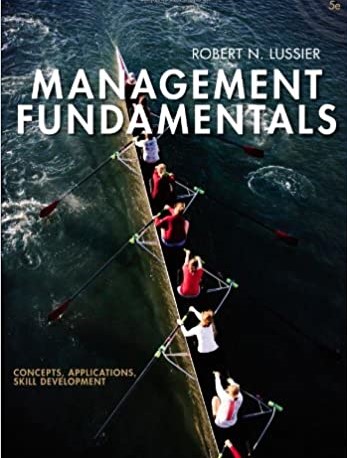
Management Fundamentals 5th Edition by Robert Lussier
Edition 5ISBN: 978-1111577520
Management Fundamentals 5th Edition by Robert Lussier
Edition 5ISBN: 978-1111577520 Exercise 16
Hitachi, headquartered in Japan, is one of the world's largest technology corporations. Hitachi products are used throughout the world in telecommunications, in energy and chemical industries, in plant engineering, and in consumer electronics. For Hitachi, manufacturing "high-tech" means being a responsible corporate citizen by developing environmentally sound solutions to customers' problems. Since its founding in 1910, Hitachi has acted from a corporate philosophy of contributing to society through technology. Recognizing that survival in the 21st century demands responding to global change, Hitachi has adopted the phrase "Inspire the Next" as a declaration of its corporate vow that the Hitachi brand will meet the expectation of its customers and society in the 21st century and beyond.
Hitachi considers its employees its most valuable assets. Their talent, know-how, and expertise make it possible for Hitachi to manufacture high-quality products that meet certified international standards. To create and keep up with whatever comes next, Hitachi uses a team approach with self-managing work teams. Team members share the management functions. Everyone on a team works together to continually improve products and processes.
The company remains a corporate vertical umbrella encompassing more than 40 subsidiaries or business units, which operate horizontally-or independently of each other. However, by the early 2000s, some of these units were not performing well. To continue to expand, Hitachi began making some organizational changes by selling some lines of business and acquiring others. From 2000 to 2010, Hitachi made 140 divestures, compared with 21 from 1990-1999. It also made 125 acquisitions, compared with just 14 in the previous decade. When Hitachi takes over another corporation, its management is usually more formal than that of the existing company. In the Japanese tradition, Hitachi's structure is formal and its organization charts show the lines of authority for each business unit of the corporate body.
Hitachi also began changing its go-it-alone strategy and creating joint ventures. One example was the 2003 establishment of Renesas Technology Corporation, a semiconductor joint venture with Mitsubishi Electric Corporation. In 2004, Hitachi and Omron Corporation agreed to jointly establish a company to combine their ATM and other information equipment businesses. In 2006, Hitachi began conducting joint work with Hewlett-Packard on key security and privacy issues. One year later, GE and Hitachi completed the first half of their agreement to form a global alliance of their nuclear businesses, creating one of the world's most comprehensive nuclear power plant and services operations that will compete for new reactor projects around the world. In 2009, Hitachi announced a three-way merger with NEC and Casio Computer with hopes to boost competitiveness in the mobile phone market. In 2010, Hitachi established a joint venture with BGR Energy Systems to design, manufacture, sell, and service steam turbines/generators and boilers. With the emphasis on collaborations with partners and group companies, Hitachi is using diverse partnerships to strengthen collaborative innovation business undertakings in various areas of operations. This will not only improve business efficiencies but also allow the companies to share in research and development endeavors.
Cumulative Case Questions
Was the use of the decision-making model appropriate in deciding how to change Hitachi?
Hitachi considers its employees its most valuable assets. Their talent, know-how, and expertise make it possible for Hitachi to manufacture high-quality products that meet certified international standards. To create and keep up with whatever comes next, Hitachi uses a team approach with self-managing work teams. Team members share the management functions. Everyone on a team works together to continually improve products and processes.
The company remains a corporate vertical umbrella encompassing more than 40 subsidiaries or business units, which operate horizontally-or independently of each other. However, by the early 2000s, some of these units were not performing well. To continue to expand, Hitachi began making some organizational changes by selling some lines of business and acquiring others. From 2000 to 2010, Hitachi made 140 divestures, compared with 21 from 1990-1999. It also made 125 acquisitions, compared with just 14 in the previous decade. When Hitachi takes over another corporation, its management is usually more formal than that of the existing company. In the Japanese tradition, Hitachi's structure is formal and its organization charts show the lines of authority for each business unit of the corporate body.
Hitachi also began changing its go-it-alone strategy and creating joint ventures. One example was the 2003 establishment of Renesas Technology Corporation, a semiconductor joint venture with Mitsubishi Electric Corporation. In 2004, Hitachi and Omron Corporation agreed to jointly establish a company to combine their ATM and other information equipment businesses. In 2006, Hitachi began conducting joint work with Hewlett-Packard on key security and privacy issues. One year later, GE and Hitachi completed the first half of their agreement to form a global alliance of their nuclear businesses, creating one of the world's most comprehensive nuclear power plant and services operations that will compete for new reactor projects around the world. In 2009, Hitachi announced a three-way merger with NEC and Casio Computer with hopes to boost competitiveness in the mobile phone market. In 2010, Hitachi established a joint venture with BGR Energy Systems to design, manufacture, sell, and service steam turbines/generators and boilers. With the emphasis on collaborations with partners and group companies, Hitachi is using diverse partnerships to strengthen collaborative innovation business undertakings in various areas of operations. This will not only improve business efficiencies but also allow the companies to share in research and development endeavors.
Cumulative Case Questions
Was the use of the decision-making model appropriate in deciding how to change Hitachi?
Explanation
Self-managing teams work tirelessly to i...
Management Fundamentals 5th Edition by Robert Lussier
Why don’t you like this exercise?
Other Minimum 8 character and maximum 255 character
Character 255


